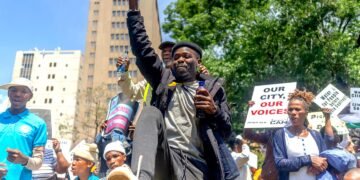1. What Happened?
In 2025, U.S.–South Africa relations plunged into one of their most turbulent phases in decades. It began with President Donald Trump freezing hundreds of millions of dollars in aid over South Africa’s Expropriation Act, 2024—a controversial law permitting land seizures without compensation—and escalated when Washington imposed steep reciprocal tariffs on South African exports. Together, these moves upended trade, threatened jobs, and reignited debates about race, geopolitics, and economic sovereignty in South Africa.
2. Timeline of Events
February 2025 – Aid Freeze and Afrikaner Refugee Offer
- Trump signed an executive order halting $440 million in aid, citing the Expropriation Act as discriminatory against Afrikaners.
- He linked the move to South Africa’s criticism of Israel at the International Court of Justice.
- Simultaneously, the administration launched “Mission South Africa”, offering asylum to white Afrikaners—a move widely rejected by those communities.
(CNN, Guardian, FT)
April 2025 – Tariffs Announced
- Trump declared 31% tariffs on South African imports under a “Liberation Day” speech, claiming trade imbalances and the need for reciprocity.
- This effectively dismantled South Africa’s duty-free benefits under AGOA (African Growth and Opportunity Act).
(Wikipedia)
1 August 2025 – Tariffs Enforced
- From this date, South African products—citrus, wine, grapes, beef, nuts, textiles, automotive parts—entered the U.S. under punishing tariffs, some as high as 30%.
- South Africa scrambled to negotiate relief, offering LNG purchases and infrastructure investments, but with little U.S. response.
(Reuters, AmCham SA)
3. Where & Why
- Where: The executive order was issued in Washington, D.C. The tariff policy was enforced by U.S. trade authorities. The fallout hit hardest in South Africa’s agricultural belts, automotive hubs, and wine-producing regions.
- Why:
- Aid Freeze: Explicitly linked to land reform and Trump’s framing of “racial discrimination” against white farmers.
- Tariffs: Officially justified as a response to trade imbalances—though many analysts saw it as a continuation of political-economic punishment.
(Washington Post, Ecofin Agency)
4. How It Unfolded
- Aid freeze disrupted U.S.-funded programs, including health initiatives. South Africa condemned it as misinformed and politically motivated.
- Tariffs imposed—Washington applied sweeping “reciprocal” measures, cutting off preferential trade.
- Economic fallout began—South African industries reported contract cancellations, order delays, and job-loss fears.
- Pretoria’s response—Ramaphosa’s government created financial support facilities, eased rules for exporters, and started diversifying trade partnerships (China, Europe, Middle East).
(Reuters)
5. Significant Impacts
Agriculture
- Exports surged 26% in Q2 2025 ($161M), but experts warned this was a last push before tariffs bit.
- Farmers across the racial spectrum—ironically including white Afrikaners Trump claimed to defend—faced devastating price pressures.
(Reuters)
Automotive
- Auto-parts producer Jendamark projected R750 million ($43M) losses, with U.S. partners reconsidering contracts.
(Reuters)
Wine Industry
- Facing a 30% tariff, far above France or Italy’s rates, wineries warned of order cancellations and mass job losses in an industry employing 270,000 people.
(FT)
Jobs
- Estimates: 30,000–100,000 jobs at risk across agriculture, manufacturing, and logistics.
(PBS)
6. Future Implications
- Market Diversification: SA is pushing deeper into Asian and Middle Eastern markets to reduce reliance on the U.S.
- AGOA’s Uncertain Future: With AGOA expiring soon, South Africa must secure new trade terms—or face long-term exclusion from U.S. markets.
- Policy Reforms: Domestic support packages may soften the blow but can’t offset lost U.S. access.
- Diplomatic Fallout: Relations between Pretoria and Washington are strained, with Trump’s race-focused framing further polarising perceptions.
- Contradiction: Trump’s stated goal of “helping white farmers” has, in practice, worsened conditions for them and for all exporters.
7. Bottom Line
Trump’s twin strikes—aid freeze over land reform and tariffs over trade—mark a turning point in U.S.–South Africa relations. What began as a political message about “protecting Afrikaners” escalated into a trade war that now threatens jobs, investment, and long-standing bilateral ties. The ultimate outcome hinges on whether South Africa can pivot fast enough to new markets and whether Washington’s hard line is temporary pressure—or the new normal in U.S. trade diplomacy.
Sources
- Washington Post Trump confronts South African president, pushing claims of genocide
- Financial Times Donald Trump and the tortured history of South Africa’s land
- Reuters South Africa’s Q2 farm exports to the US surge, but tariffs dampen prospects
- Reuters South African auto parts group Jendamark braces for US tariff hit
- Financial Times Grapes of wrath: South African wineries hit by 30% US tariffs













![[WATCH] SIU raids Maumela’s mansion, seizes three Lamborghinis. 13 temp 3c0c40d1 a70f 4ecc a3fb 7daa4ca2bf4e](https://dailydivenetwork.com/wp-content/uploads/2025/10/temp_3c0c40d1-a70f-4ecc-a3fb-7daa4ca2bf4e-120x86.jpg)










